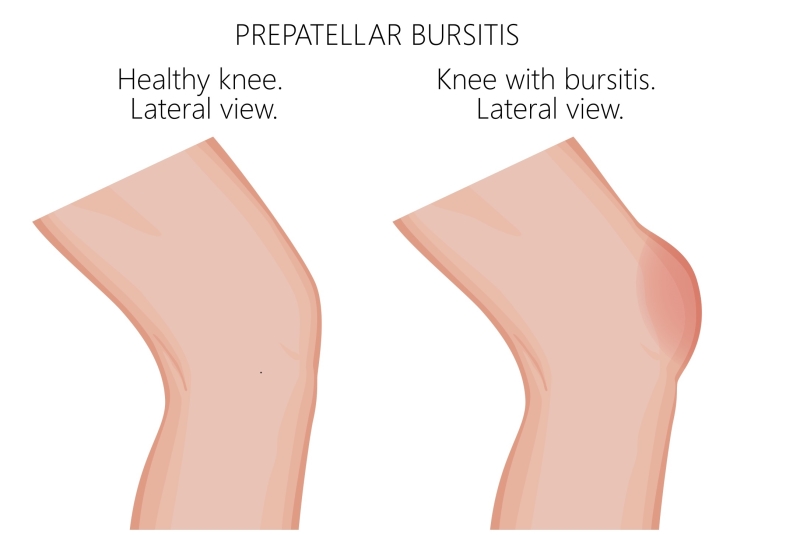Housemaid’s knee, also known as prepatellar bursitis or kneecap bursitis, causes swelling and pain at the front of the knee. So, why is it called ‘housemaid’s knee,’ and what can you do about it?
What is a housemaid’s knee?
A housemaid’s knee is a swelling in the sac at the front of the knee, called the prepatellar bursa. This sac sits on top of the kneecap. The prepatellar bursa is one of four bursae in the knee. Less frequently, other bursae are affected.
What causes the housemaid’s knee?
Causes of prepatellar bursitis include:
- A fall on the knee.
- Repeated minor injuries occur when kneeling on the knee for long periods. This kneeling is typical for housemaids; hence, we use the term housemaid’s knee. However, other workers, such as carpenters, plumbers, and rugby players, are also at risk.
- Infection. A break in the skin can lead to infection in the bursa, causing pain and swelling.

Housemaids knee symptoms
Prepatellar bursitis causes pain and swelling at the front of the knee. Pain and swelling can occur suddenly or gradually. Pain occurs with kneeling or other direct pressure. Often, people describe sharp, needle-like pain when kneeling. Also, stiffness of knee movements and general tightness are common. In cases of infection, the skin may feel hot to the touch, and you may experience symptoms such as fever.
Also, it is common to have an indent in the knee due to swelling.
Your doctor should rule out other causes of knee pain and swelling, such as runner’s knee, cartilage damage, or other types of knee bursitis, including infrapatellar bursitis.
Investigations such as ultrasound or MRI can help diagnose Housemaid’s knee and rule out other causes.
How do you treat kneecap bursitis?
Generally, treatment depends on the cause.
In infective prepatellar bursitis, we suggest high-powered antibiotic tablets. Sometimes, patients need to be hospitalised for intravenous antibiotics. Occasionally, surgery to remove the infection may be necessary.
In non-infectious prepatellar bursitis, simple treatments are usually adequate. Firstly, avoiding activities that aggravate bursitis, such as kneeling, can be helpful. Secondly, knee padding and stretches for bursitis can protect the knee from further friction. Finally, anti-inflammatory tablets such as ibuprofen can reduce inflammation.
Sometimes, in cases that don’t settle with simple treatments, you may be offered a cortisone shot as the next step for kneecap bursitis.
How long does the Housemaid’s knee last?
Generally, kneecap bursitis lasts weeks to months and may recur if irritation from kneeling persists. Overall, however, symptoms gradually improve with treatment.
More about a cortisone shot for a housemaid’s knee
Cortisone is a powerful drug that reduces inflammation. Prepatellar bursitis is an inflammatory condition, so it makes sense that we would inject cortisone into the bursa to alleviate the symptoms.
Generally, injections should be performed with ultrasound to improve accuracy and effectiveness. Ultrasound enables the doctor to confirm the correct diagnosis and avoid injecting into the wrong structures, such as knee tendons. However, injecting cortisone with ultrasound can introduce infection, so you must be careful. Therefore, we suggest asking these four questions before undergoing an ultrasound-guided injection.
Initially, we use a numbing shot such as lidocaine. Then, we drain fluid from the bursa using a needle under ultrasound. Finally, a small dose of cortisone is injected into the knee bursa to stop the fluid from returning. After the cortisone shot for the Housemaid’s knee, we apply pressure to the front of the knee to prevent it from coming back. Also, wearing a protective sleeve or knee padding is essential to protect the knee from further friction.
In rare cases, patients may require surgery to remove the bursa if all other treatments are unsuccessful.
Final word from Sportdoctorlondon about Prepatellar Bursitis
Prepatellar bursitis is a common but benign condition that is more of a nuisance than a serious issue. Simple treatments, such as ice, compression, and knee padding, often provide relief. However, a cortisone shot might help stubborn cases.



Leave A Comment